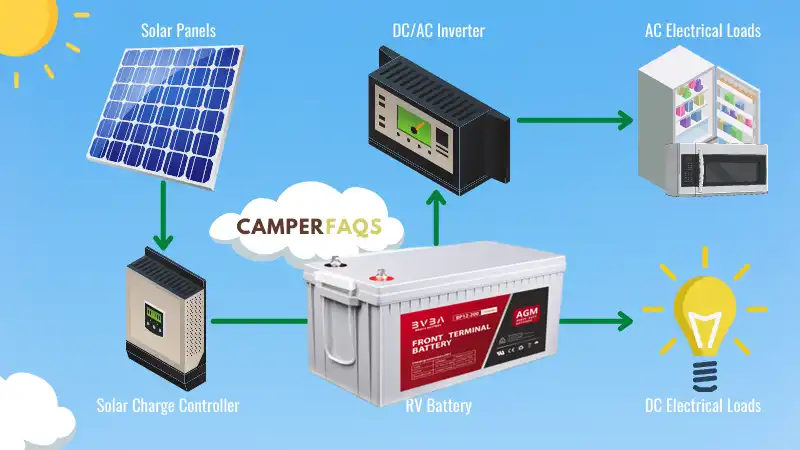To charge a camper battery, use a battery charger or connect it to a solar panel. Ensure proper connections to avoid damage.
Keeping your camper battery charged is crucial for a successful trip. A fully charged battery powers essential appliances and devices. Proper charging methods extend battery life and efficiency. Using a battery charger or solar panel are common methods. These tools ensure your battery stays at optimal levels.
Regular maintenance and monitoring help prevent unexpected power failures. Investing in a quality charger or solar system offers long-term benefits. Always follow safety guidelines to protect your equipment. Proper charging techniques save you time and money. Enjoy your camping experience with a reliable power source.

Credit: www.wikihow.com
Safety Precautions
Charging a camper battery requires attention to safety precautions. By following these guidelines, you can prevent accidents and ensure your safety.
Handling Batteries Safely
When handling batteries, make sure to follow these important steps:
- Always read the battery manufacturer’s instructions before starting.
- Keep the battery in an upright position to prevent leaks.
- Ensure the area is well-ventilated to avoid inhaling fumes.
- Never smoke or use open flames near the battery.
- Disconnect the battery from the camper before charging.
Handle the battery with care to avoid dropping it. A dropped battery can leak acid or get damaged.
Protective Gear
Wearing protective gear is essential when charging a camper battery. Here’s what you need:
| Gear | Purpose |
|---|---|
| Gloves | Protect your hands from acid and chemicals |
| Goggles | Shield your eyes from splashes |
| Apron | Prevent acid from contacting your clothes |
Always inspect your protective gear for any damage before using it. Replace any damaged gear immediately to ensure your safety.

Credit: www.bravabatteries.com
Battery Types
Understanding the different types of camper batteries is essential. It helps ensure your camper stays powered during your adventures. Here are the main types of batteries used in campers:
Lead-acid Batteries
Lead-acid batteries are the most common type. They are reliable and affordable. There are two main types of lead-acid batteries:
- Flooded Lead-Acid Batteries: These need regular maintenance. You must check water levels often.
- Sealed Lead-Acid Batteries: These are maintenance-free. They are also known as AGM (Absorbent Glass Mat) batteries.
Lead-acid batteries have some advantages:
- Low cost
- Reliable performance
- Widely available
They also have disadvantages:
- Heavy weight
- Shorter lifespan
- Require regular maintenance (for flooded types)
Lithium-ion Batteries
Lithium-ion batteries are newer and more advanced. They offer several benefits:
- Lightweight
- Longer lifespan
- Higher energy density
These batteries are perfect for long trips. They require minimal maintenance. Some key points about lithium-ion batteries:
- More expensive than lead-acid batteries
- Recharge faster
- Can be discharged deeper without damage
Here is a comparison table:
| Feature | Lead-Acid | Lithium-Ion |
|---|---|---|
| Weight | Heavy | Lightweight |
| Lifespan | Short | Long |
| Maintenance | High (for flooded) | Low |
| Cost | Low | High |
Charging Methods
Knowing the right charging methods for your camper battery is essential. Here, we will explore three popular methods: using a generator, solar panel charging, and shore power charging.
Using A Generator
Generators are a reliable way to charge your camper battery. They provide power whenever needed, making them ideal for off-grid camping. Generators convert fuel into electricity, which then charges your battery.
- Start the generator according to the manufacturer’s instructions.
- Connect the generator to the camper’s battery using the appropriate cables.
- Monitor the battery voltage to avoid overcharging.
Always ensure the generator is well-ventilated and never run it inside your camper.
Solar Panel Charging
Solar panels are a sustainable way to charge your camper battery. They convert sunlight into electricity, which charges the battery.
- Set up the solar panels in a sunny location.
- Connect the solar panels to a charge controller.
- Attach the charge controller to your camper battery.
Solar panels are quiet and environmentally friendly. Ensure they are clean and free from obstructions for maximum efficiency.
Shore Power Charging
Shore power charging involves plugging your camper into an external power source. This is common at campgrounds and RV parks.
| Step | Description |
|---|---|
| 1 | Locate a shore power outlet at your site. |
| 2 | Plug the camper’s power cord into the outlet. |
| 3 | Ensure the camper’s power system is set to shore power. |
Shore power provides a consistent and reliable charge. Always use a surge protector to safeguard your electrical system.
Choosing The Right Charger
Picking the right charger for your camper battery is crucial. It ensures your battery stays healthy and lasts longer. Below, we’ll discuss charger specifications and compatibility with battery types.
Charger Specifications
Understanding charger specifications is key. These specifications tell you if the charger fits your needs. Here are some important ones:
- Voltage: Ensure the charger matches your battery’s voltage.
- Amperage: Higher amperage means faster charging. Choose based on your time needs.
- Smart Charging: Smart chargers prevent overcharging. They automatically adjust the charge.
- Portability: Portable chargers are great for on-the-go use.
| Specification | Description |
|---|---|
| Voltage | Should match the battery’s voltage |
| Amperage | Higher amperage charges faster |
| Smart Charging | Prevents overcharging |
| Portability | Easy to carry and use |
Compatibility With Battery Types
Not all chargers work with every battery type. Make sure your charger is compatible with your battery. Here are common battery types:
- Lead-Acid Batteries: Common in campers. They need a specific charger type.
- AGM Batteries: Absorbent Glass Mat batteries. They require a special charger.
- Lithium-Ion Batteries: These are lightweight and efficient. Ensure your charger supports them.
Check your battery’s manual for the best charger recommendations. Using the wrong charger can damage your battery. Always ensure compatibility before buying.
Step-by-step Charging Process
Charging your camper battery is crucial for a successful trip. Follow this step-by-step guide to ensure your battery is charged correctly.
Preparing The Battery
Before starting, ensure your battery is ready for charging. Follow these steps:
- Turn off all electrical devices in the camper.
- Disconnect the battery from the camper’s system.
- Check the battery terminals for dirt or corrosion. Clean if necessary.
- Inspect the battery for any visible damage.
Connecting The Charger
Next, connect the charger to the battery. Follow these instructions carefully:
- Place the charger near the battery.
- Attach the positive cable (usually red) to the positive terminal.
- Connect the negative cable (usually black) to the negative terminal.
- Plug the charger into a power source.
- Set the charger to the appropriate voltage and charge rate.
Monitoring The Charge
While the battery is charging, keep an eye on the process:
- Check the charger’s display or indicator lights.
- Avoid overcharging by setting a timer or using an automatic charger.
- Ensure the battery does not overheat.
- Unplug the charger once the battery is fully charged.
Following these steps ensures a safe and efficient charging process. A well-charged battery means a worry-free camping experience.
Maintaining Battery Health
Maintaining your camper battery health is crucial for long-lasting performance. Proper care ensures your battery remains efficient and reliable. Below are key practices to keep your battery in top shape.
Regular Inspections
Regular inspections help identify potential issues early. Check the battery terminals for corrosion. Ensure the connections are tight and secure. Look for any visible damage to the battery casing. Inspect the water levels in lead-acid batteries. Top up with distilled water if needed.
Cleaning And Storage Tips
Clean your battery terminals to prevent corrosion. Use a mixture of baking soda and water. Scrub gently with a brush. Rinse and dry thoroughly. Store your battery properly during off-seasons. Keep it in a cool, dry place. Avoid direct sunlight and extreme temperatures. Disconnect the battery from your camper. Charge it fully before storage.
Follow these tips to maintain your camper battery health. A well-maintained battery ensures a smooth camping experience.
| Maintenance Task | Frequency |
|---|---|
| Inspect Terminals | Monthly |
| Check Water Levels | Every 3 Months |
| Clean Terminals | Every 6 Months |
| Charge Fully Before Storage | Before Storing |
Troubleshooting Common Issues
Charging a camper battery can sometimes be tricky. You might face some common issues. Here, we will address these problems. Let’s dive into the solutions.
Battery Not Charging
If your battery is not charging, there could be several reasons. Here are some common causes and solutions:
- Faulty Charger: Check if the charger is working. Use a multimeter to test it.
- Loose Connections: Ensure all connections are tight. A loose connection can prevent charging.
- Dirty Terminals: Clean the battery terminals. Dirt can block the charge.
- Dead Battery: Test the battery with a voltmeter. Replace it if it’s dead.
Overheating Problems
Overheating can damage your battery. Here are some tips to prevent it:
- Adequate Ventilation: Ensure your battery has enough ventilation. This helps dissipate heat.
- Proper Charger: Use the correct charger for your battery. An incorrect charger can cause overheating.
- Regular Monitoring: Check the battery temperature regularly. Use a thermometer if needed.
- Rest Periods: Give your battery rest periods during long charging sessions. This helps cool it down.
Follow these tips to keep your camper battery in top condition. Enjoy a hassle-free camping experience!
Credit: www.jeepgladiatorforum.com
Frequently Asked Questions
How Long Does It Take To Charge A Camper Battery?
Charging time depends on the battery type and charger. Typically, it takes 4 to 8 hours to fully charge.
What Is The Best Way To Charge A Camper Battery?
The best way is using a smart charger. It prevents overcharging and maintains battery health.
Can You Charge A Camper Battery While Driving?
Yes, you can charge it using your vehicle’s alternator. It’s efficient and convenient for long trips.
How Often Should I Charge My Camper Battery?
Charge your camper battery every month when not in use. This helps maintain its lifespan and performance.
Conclusion
Charging your camper battery is crucial for a seamless adventure. Follow these steps to ensure a reliable power source. Regular maintenance extends battery life and performance. With these tips, you can enjoy worry-free trips and keep your camper ready for the road.
Stay powered up and explore confidently!

